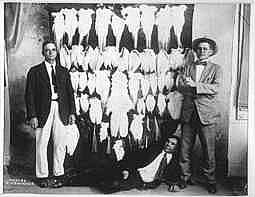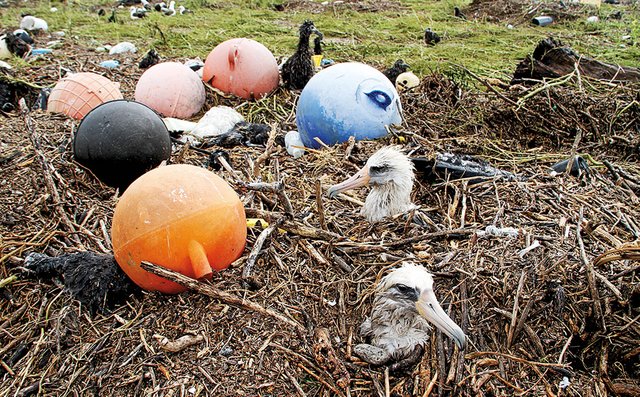Cornell Lab of Ornithology: The Resilient Laysan Albatross
The Laysan Albatrosses have survived the feather trade, commercial fishing, and plastics. There are 22 albatross species around the world, of which 15 species are vulnerable or endangered according to the International Union for Conservation of Nature (IUCN). However, the population of Laysan Albatrosses is at its highest in a century.
Laysan Albatross
The Laysan Albatross lives in the open sea, a pelagic bird, on the open Pacific Ocean.

Image Source
Riding the winds Laysan Albatrosses can soar hundreds of miles per day.

Image Source
Breeding colonies can be found on the Hawaiian islands of Oahu and Kauai during the months of November to July.

Image Source
Range Map

Image Source
A True Survivor
The Laysan Albatross has survived the feather trade, industrial fishing, and the ocean garbage patch. And now the Laysan Albatross is up against the forces of nature from a changing planet.
The Feather Trade
At the start of the 20th century the feather trade decimated the population of Laysan Albatrosses.
Designers in Paris, New York, and other fashion centers adorned hats with feathers. To increase sales designers created more exotic hat designs and feather displays.

Image Source
To meet the demand for feathers millinery houses in America and Europe traded bird feathers internationally.

Image Source
To supply Western hat designers and makers, Japanese feather hunters began eradicating Hawaiian seabird colonies in 1902. Before the hunting began there was an estimated half-million breeding pairs of Laysan Albatrosses on the Laysan Island. The National Audubon Society and the Migratory Bird Treaty Act of 1918 put an end to the feather trade. After the feather trade was banned in 1922, it was estimated there were only 18,000 breeding pairs of Laysan Albatrosses in the world.
The resilient Laysan Albatrosses made a comeback. By 1958 it was estimated that there were 280,000 breading pairs of Laysan Albatrosses.
Industrial Fishing
The demand for seafoods such as tuna, haddock, cod, swordfish, and Chilean sea bass in the 20th century created the commercial fishing industry. The commercial fishing fleets employed two different kinds of fishing techniques, drift nets and longline rigs, that are particularly bad for albatrosses.
Drift Nets

Image Source
It was estimated that commercial drift net fishing in the open North Pacific ocean was killing 27,500 albatrosses per year.
In 1992 drift netting was banned by international agreement.
Longlines

Image Source
Commercial longline fishing fleets use lines up to 60 miles long. An Australian biologist in 1991 estimated that commercial Japanese longline tuna fleets were setting over 100 million hooks and killing 44 thousand albatrosses per year.
Biologists worked with longline fishermen to develop a strategy that was straightforward, inexpensive, didn't reduce the fish catch, and prevented bird deaths.

Image Source
Three simple measures were found to be 90% effective when used together.
- Hang gaudy streamer lines behind the longline ship to scare birds away from the freshly baited hooks as they sank.
- Weight the freshly baited lines so that they sink faster.
- Only bait the hooks at night. This is because seabirds are less active at night.
Great Pacific Garbage Patch

Image Source
Between the U.S. states of California and Hawaii in the Pacific Ocean lies an area known as the Great Pacific Garbage Patch. It is estimated to be three times the size of France and be comprised of 79 thousand tons of plastic in the form of 1.8 trillion pieces.
The Ocean Cleanup Foundation studied the Great Pacific Garbage Patch and produced this map of where the plastic becomes the most dense.

Image Source
Some of the debris in the Great Pacific Garbage Patch came from the 2011 tsunami that struck Japan.
An environmental engineer at the University of Georgia determined that an estimated 8 million tons of plastic is being added to the oceans each year.
Researchers estimate that cumulatively Laysan Albatrosses feed their chicks 5 tons of plastic each year. The Laysan Albatrosses actually are eating the plastic on purpose because they are a substrate for flying fish eggs. The plastic alone does not pose a problem for the albatrosses. However, accumulated toxins can pose a threat to the albatrosses.
Before their first flight, albatross chicks cough up plastic to clear their stomach. By the time one albatross chick studied by Cornell Lab named Kaloakulua was 4 months old she had plastic in her stomach. Here is a video of the regurgitated plastic and other indigestible items that were in Kaloakulua's stomach.
4 minute video published by LabofOrnithology on 3 June 2014
Planetary Changes
The estimated 600 thousand breeding pairs of Laysan Albatrosses are now facing the forces of nature. A changing climate and planet are threatening the Laysan Albatrosses.
Laysan Albatrosses nest on atolls scattered across the tropical Pacific. Here is a webcam snapshot from the Midway Atoll Wildlife Refuge, the largest Laysan Albatross colony in the world.

Image Source
In 2011 there were two large winter storms that hit the Midway Atoll. The storms washed away an estimated 10 thousand Laysan Albatross eggs.
A few weeks later the tsunami originating from Japan hit the Midway Atoll. The 5 foot tsunami flooded much of the Midway Atoll. The tsunami killed an estimated 212 thousand chicks and trapped birds in enormous drift piles.

Image Source
The United States Fish and Wildlife Service estimated another 42 thousand Laysan Albatrosses were killed on other Hawaiian atolls.
Hope for the Future
Albatrosses are moving to higher ground. Adapting to planetary changes albatrosses have been observed moving to higher ground for nesting.

Image Source
However, moving to higher ground brings new problems as nesting albatrosses move into proximity of where people live.
Yet with all the issues the Laysan Albatross population has had to deal with the historical resilience of the species gives researchers hope.
Sources and Resources
Laysan Albatrosses Survived The Feather Trade, Industrial Fishing, And Plastics. What’s Next?, The Cornell Lab of Ornithology, All About Birds, 19 December 2017
Facing Into the Wind: The Complicated Fate of the Laysan Albatross, The Cornell Lab of Ornithology, All About Birds, 26 September 2014
Laysan Albatross, The Cornell Lab of Ornithology, All About Birds
The Feather Trade, Smithsonian Institution
How Two Women Ended the Deadly Feather Trade, Smithsonian.com, March 2013
Plastic within the Great Pacific Garbage Patch is ‘increasing exponentially,’ scientists find, Washington Post, 22 March 2018
Thank You!
Thank you!
You got a 20.00% upvote from @bid4joy courtesy of @etcmike!
You got a 19.14% upvote from @th3voter thanks to: @etcmike!

Image Source cloudinary.com
This post has upvoted from @th3voter !For more information, click here!
You can earn daily profit by delegating SP to our bot, 100% of earnings paid out to delegators. To do so, click below:
30SP, 50SP, 100SP, 250SP, 500SP, 1000SP, 5000SP, 10000SP,
Custom Amount
Make sure you have at least 15 SP left on your account.
Awesome blog post sir and amazing photography as well.
Awesome blog post sir great research you have put into this.
sir,it's very bad Laysan Albatrosses have survived the feather trade this is not good news for world same type problam survived in indian peacock sale and purchase of peacock feathers. There should be strict law implemented against this in every country to preserve animals. Every citizen should be aware to protect our environment.
I like this post so i am upvoting it.
I agree and it also takes society to realize what affect their consumerism is having on the ecology.
Have a great week!
Steem on,
Mike
It's good to see that you are really concerned about such topics which need more light to be thrown on. Your posts are really great and deep thought is put into your every post so I upvote it.
their beautiful birds live freely in open, so sustainability always awake, you have given new picture me @etcmike,☺️
I am the first how comments on you post🙂 and hope received upvote...
What impotence @etcmike, seen in figures is incredible the amount of plastic that reaches the oceans and sadder that this beautiful species is affected. It's good that the fishermen change their techniques, but we should change all of them.
Thank you for the valuable information! It´s very important to know!
I was surprised about the size of the Great Pacific Garbage Patch and to learn how the Laysan Albatross actually seeks out plastic to eat.
I try to recycle as much plastic as I possibly can. It helps both our landfills and our waterways/oceans.
Have a great week!
Steem on,
Mike
Thank you so much for using our service! You were protected from up to 20% losses!
Help us grow by delegating to us! 100sp, 500SP, 1000SP, ANY SPYou just received 57.37% upvote from @onlyprofitbot courtesy of @etcmike!